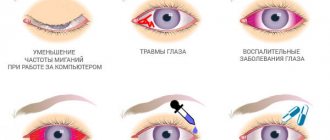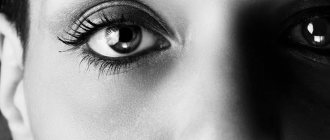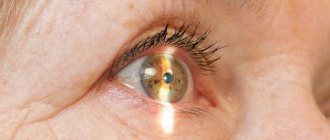Each of these elements takes part in capturing and projecting rays of light, which are subsequently transformed by the brain into a visible image of the correct perspective. But this process is partially disrupted in old age, which leads to gradual degradation of vision. It is impossible to completely prevent this, but minimizing the negative effect is quite possible. The most important thing is to choose the right eye drops for older people.
Who needs eye vitamins?
Proper nutrition is a source of vitamins, micro- and macroelements necessary for the normal functioning of all organs, including the eyes. However, rarely can anyone boast of a balanced diet. Moreover, it is now almost impossible to find natural, environmentally friendly products: supermarkets sell products with all kinds of preservatives, GMO additives and substitutes for natural ingredients, and agricultural products often contain harmful nitrates. And the environmental situation in most cities leaves much to be desired and adversely affects the immunity and health of residents.
If earlier the emphasis was on taking vitamin complexes in the form of tablets, now ophthalmologists are increasingly prescribing eye vitamins in drops. And this is correct, because the tablet first enters the gastrointestinal tract, from where it is absorbed into the blood and distributed through the bloodstream throughout the body. Tablet drugs can have side effects on the stomach and intestines; in some patients, certain substances are not absorbed at all due to insufficient production of the necessary enzymes. When eye drops with vitamins are used, the beneficial substances immediately enter the organ of vision and begin to have a therapeutic effect.
Vitamin eye drops are prescribed primarily to older people over 60 years of age.
But besides them, the risk group includes several more categories:
- Patients with vision problems - myopia or farsightedness. In their case, vitamins will help stop the progression of the disease and deterioration of vision.
- Workers engaged in constant long-term work at the computer. Long-term work is considered to be 5-6 hours a day or more. These can be office workers, freelancers, and computer game lovers. Eyes with increased load and constant tension simply need additional fortified preparations.
- Patients diagnosed with cataracts or glaucoma. Feeding with nutrients will help stop or slow down destructive processes.
- Patients with type 1 and type 2 diabetes mellitus. This disease often adversely affects the condition of the eyes.
- Suffering from varicose veins. Women often fall into this group, although the disease can manifest itself regardless of gender and at any age. Typically, varicose veins are accompanied by pathologies in the fundus of the eye, accompanied by the formation of blood clots.
- People whose age is 40-45 years and older. Vitamin drops will help delay unfavorable age-related changes in healthy people and stop pathological processes in those who already have vision problems.
Using modern vitamin preparations in the form of eye drops, you can stop the aging process, because they contain a lot of useful substances that have a positive effect on vision in any pathology.
Important! Only an ophthalmologist can tell which vitamin drops are best for the eyes. You should not rely on the advice of friends or pharmacy workers. Only a doctor is able to correctly assess the condition of the eyes, make an accurate diagnosis and prescribe adequate therapy. Self-medication of the organ is fraught with side effects and deterioration of eye health.
What happens to the eyes of older people?
The elasticity of the lens is maintained by the so-called ciliary muscles. With their help, its shape changes, its convexity is adjusted, due to which the accommodative effect is achieved, that is, the eye is able to focus on both close and distant objects. Due to a decrease in the activity of the ciliary muscles, the correct process of changing the shape of the lens is disrupted. Most often, this leads to the development of farsightedness: a person sees normally in the distance, but has problems focusing on near objects. It is for this reason that older people, when reading a book or newspaper, move them as far away as possible (with normal vision, a distance of 30 cm is sufficient, for older people - about 60 - 80 cm).
At the same time, at an age close to retirement, the following visual disturbances occur:
- Reduced sensitivity of the retina. Even if the ciliary muscles work normally and focusing occurs as expected, vision will still be reduced due to retinal immunity. For some this is accompanied by a “blurred” image, for others there are signs of color blindness, for others it is not possible to quickly focus on a specific object (regardless of the distance to it).
- Cloudiness of the vitreous body occurs. Most often accompanied by the appearance of spots, “sparks”, “dots” in front of the visible image. In some cases, these are the consequences of normal degradation of the eyeball, but sometimes the symptom also indicates the initial stage of retinal detachment. All this occurs mainly due to a lack of vitamin E in the body (a consequence of changes in metabolic processes).
- There is a difference in intraocular and external pressure. In the future, this leads to the development of glaucoma. This is accompanied by frequent “tiredness” of the eyes, but subsequently retinal detachment and optic nerve atrophy are observed. If the disease is not detected in a timely manner, then it all ends in complete blindness without the possibility of further restoration of vision.
- Impaired lacrimation. It may be accompanied by both increased dryness of the cornea and an excessive amount of tears (this is how the body tries to neutralize the lack of moisture). In addition to this, the density of tears itself decreases, causing the cornea to be exposed to increased negative environmental influences and bright light.
It is necessary to understand that the eye of an elderly person degrades to one degree or another in any case, which is a feature of the human body. And it is impossible to completely prevent these changes. The task of ophthalmologists is to prescribe therapy that will slow down the physiological degradation of the visual organ and prevent the development of more complex diseases.
Effective drops
The list of modern fortified preparations in the form of eye drops is quite large. Let’s focus on the most effective ones, as evidenced by patient reviews.
- Taufon.
'Taufon' drops are available in bottles of 5 and 10 ml. The main active ingredient is taurine, a sulfur-containing amino acid. Taurine is found in some foods. But in the form of an aqueous 4% solution, after instillation (installation) into the eyes, it begins to act much faster. Taurine stimulates recovery processes in cases of dystrophic or traumatic damage to the retina associated with malnutrition.
'Taufon' is prescribed for the following pathologies of the retina:
- corneal dystrophy,
- hereditary taperetinal degeneration,
- senile cataract,
- diabetic cataract,
- radiation cataract,
- corneal injuries (as a means of stimulating the recovery process).
The drug slightly reduces intraocular pressure in glaucoma (in patients with increased intraocular pressure). According to patient reviews, Taufon helps relieve fatigue, eliminate inflammation, redness, dry eye syndrome and other uncomfortable sensations. The drug will be useful not only for older people, but also for younger patients who are forced to spend most of their working day at the computer.
The advantage of Taufon is its affordable price, absence of contraindications and side effects.
- Riboflavin.
Riboflavin is vitamin B₂, without which hemoglobin synthesis, as well as protein, carbohydrate and fat metabolism, are unthinkable. Paired with retinol (vitamin A), riboflavin plays an important role in normalizing visual processes:
- enriches eye tissue with oxygen,
- facilitates the conduction of nerve impulses,
- restores the functioning of the retina of the eye,
- heals tissue damaged by injuries and burns.
The list of indications for the eye drops of the same name 'Riboflavin' includes:
- night blindness or hemeralopathy (in this case, treatment should be carried out in combination with retinol),
- conjunctivitis,
- keratitis,
- iritis (inflammation of the iris),
- decreased visual acuity,
- eye fatigue associated with prolonged exercise,
- ulcers or wounds of the cornea that do not heal for a long time.
Riboflavin drops are contraindicated for use by those who have an individual intolerance to vitamin B₂. There are no other prohibitions regarding the drug - it can be instilled even by pregnant and lactating women.
Riboflavin solution is often combined with other medications - their interaction gives a more lasting positive effect. Thus, for cataracts, 'Riboflavin' is prescribed with eye drops 'Oftan Katahrom' or 'Quinax'; for the treatment of ulcers and burns, these eye drops are combined with vitamin A; for the treatment of allergic conjunctivitis - with 'Okumethyl' drops.
- Quinax.
Quinax eye drops are intended for the treatment of cataracts: congenital, senile, traumatic or secondary. The drug has no side effects and has no contraindications, except in cases of individual intolerance.
'Quinax' is a therapeutic and prophylactic drug and a good antioxidant that protects the lens from the negative effects of free radicals. Drops promote the resorption of opaque protein compounds and increase the transparency of the lens.
- Catalin (Sankatalin, Sencatalin).
These drugs are complete analogues of the main active ingredient – sodium pyreneoxine. Their description, indications for use and therapeutic dose are completely the same. These eye drops prevent the development of cataracts regardless of the cause, be it old age, diabetes or injury. 'Catalin' is considered one of the most effective drugs for cataracts and is used not only for therapeutic, but also for preventive purposes.
'Katalin' has a beneficial effect on the organs of vision:
- regulates and improves metabolism in eye tissues,
- neutralizes quinones,
- prevents protein breakdown in the lens,
- reduces the risk of age-related lens opacification.
'Katalin' and its analogues are available in the form of tablets and isotonic solution, bottled in 15 ml bottles. To prepare drops, a tablet of the main substance is dissolved in saline and used according to the instructions for use. The therapeutic effect appears within 2 weeks from the start of using the drug, however, to consolidate the result, the drops must be used for a long time.
- Oftan Katahrom.
'Oftan Katahrom' contains three active components: cytochrome, adenosine and nicotinamide. The complex action of the listed substances has healing properties:
- restores tissues,
- stimulates the metabolic processes of the lens and eye tissues,
- protects the organ of vision from damage by free radicals,
- prevents clouding and restores lens cells,
- improves eye blood circulation,
- moisturize the surface of the eye,
- has an anti-inflammatory and antibacterial effect.
Although the instructions for the drug indicate that Oftan Katahrom is used to treat cataracts, ophthalmologists prescribe it to many patients who are under 50 years of age. The therapeutic and prophylactic complex not only heals, but also prevents the development of cataracts, cleanses the lens, eliminates dryness and spots in the eyes.
Analogues of the drug 'Oftan Katahrom' are eye drops 'Vitafacol' and 'Vita-Iodural' - despite different names, their composition, purpose and other characteristics are almost identical.
Important! Vitamin drops for eyes for myopia, farsightedness, cataracts and other pathologies are used in long courses from 1 to 3 months. After each course, be sure to take a break of at least 1 month. The total duration of treatment with a particular drug and the individual treatment regimen should be determined by an ophthalmologist, and following his recommendations will give good results.
There are a number of drugs that are relevant for older people - these are anti-allergic and anti-inflammatory eye drops. During the flowering period of certain types of plants, many experience unpleasant allergy symptoms, which also include swelling, itching, redness or watery eyes. Allergies can manifest themselves to various irritating factors: dust, pet hair, food, household chemicals or medications. Eye drops will help you cope with it:
- 'Claritin',
- 'Octilia',
- 'Opticrom',
- 'Ifiral',
- 'Cromohexal',
- 'High Crom',
- 'Alomid'.
The listed drugs quickly eliminate allergy symptoms and discomfort in the eyes associated with its manifestations.
Types of funds
All drops for eye treatment are divided into several separate groups, depending on the pharmacological action:
- Vitamin preparations. They contain a group of vitamins that have a strengthening effect on eye tissue and stimulate their rapid regeneration. Such medications are prescribed for excessive eye strain, which leads to irritation and redness of the mucous membrane. They eliminate inflammation and dystrophic changes. Often prescribed for the prevention of dangerous diseases such as cataracts and glaucoma.
- Antiglaucoma. Medicines in this group are prescribed in cases where the circulation of intraocular fluid is impaired and when eye pressure increases. The active substances of such drugs normalize the production of tear fluid and then ensure its timely outflow. With timely treatment, the development of glaucoma can be prevented.
- Anti-cataract. Such drugs prevent the appearance of protein deposits on the lens and significantly slow down the development of the disease. Thanks to such medicinal solutions, fluid circulation inside the eye improves and cells are quickly restored.
- Moisturizers or artificial tears. These solutions are used for dry and irritated eyes caused by extreme fatigue. Medicines in this group can be used when wearing contact lenses to reduce discomfort. They form a film on the mucous membrane that protects the eye from negative effects.
The advisability of using certain eye drops is determined by the attending physician. Before starting to use any medications, you must carefully read the instructions.
Some eye drops are prescribed over a long period of time. In this case, the patient should be periodically examined by a doctor. If there is no effect from the treatment, then the medicine is replaced with another.
Preparations with natural extracts
In addition to chemical compounds, natural components are also used in the treatment of eye pathologies - extracts and extracts of plants that have a positive effect on the visual organs. They are included in multivitamin complexes aimed at improving eye health:
- Okovit.
The drug contains blueberry extract. 'Okovit' is prescribed for initial cataracts, significant visual stress, retinal and vitreous dystrophy, and other age-related changes. Under the name 'Okovit', different manufacturers produce several types of drugs, but all of them are vitamin complexes and are aimed at improving the condition of patients with eye pathologies, as well as preventing age-related changes.
- Visiomax.
'Visiomax' contains marigold extract, grape and blueberry peels, folic acid and several essential vitamins. Stops degenerative processes of the eye in older people, reduces eye sensitivity to allergens and improves vision. The drug will be effective with long-term use for patients diagnosed with myopia.
- Focus.
'Focus' capsules contain blueberry extract, lutein, beta-carotene, lycopene and a number of vitamins. This drug is suitable for improving vision in myopia, reducing eye fatigue during visual stress, slowing down age-related changes in the tissue of the retina and lens of the eye.
- Ultraklia.
The drug is distributed by Vitamax, which supplies products from well-known pharmaceutical companies to the Russian market. The Vitamax vitamin complex is taken for glaucoma, cataracts, myopia, farsightedness, and retinopathy. The balanced formula of the drug is an excellent source of additional nutrition for the tissues of the organ of vision.
Popular vitamin complexes also include:
- Mirtilene Forte,
- Oculist,
- Equit-sightedness,
- Adruzen Tsinko,
- Lutein Complex,
- Vitrum Vision,
- Blueberry forte,
- Doppel Hertz Active: eye vitamins with lutein.
Important! Any treatment is much more effective if carried out in combination. By agreement with the doctor, vitamin tablets can be taken in parallel with drops or taken during the break between courses of installations. For example, use Quinax drops for 3 months, then take a break for 2 months and during this time drink Okovit vitamins with blueberry extract.
Vitamin complexes for the eyes to improve vision are not medications. They are classified as dietary supplements - biologically active additives. But this does not reduce their usefulness for the human body in general and for the eyes in particular. After all, every pharmaceutical company, be it the German Queisser Pharma or the Russian Vitamax, spends a lot of time and money on research, as a result of which an effective vitamin preparation is created. It is advisable to take multivitamins at least once a year.











